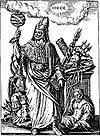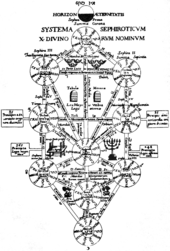From Wikipedia, the free encyclopedia
This article is about traditional Hermetic Qabalah. For other Kabbalistic traditions see Kabbalah, Christian Kabbalah, and Practical Kabbalah
Part of a series of articles onHermeticism |
|---|
| Hermetic Religion Hermeticism Mythology Hermes Trismegistus · Thoth · Poimandres Hermetica Corpus Hermeticum · Kybalion Three Parts of the Wisdom of the Whole Universe Alchemy · Astrology · Theurgy Influence and Influences Hermetic Movements Rosicrucianism Orders Hermetic Order of the Golden Dawn · Hermetic Brotherhood of Luxor · Hermetic Brotherhood of Light · Ordo Templi Orientis Topics in Hermetism Qabalah Occult and divinatory tarot Hermetists and Hermeticists John Dee . Aleister Crowley · Israel Regardie Thābit ibn Qurra · Paracelsus Giordano Bruno · Ahmad al-Būni · Samuel MacGregor Mathers · William Westcott Franz Bardon · Samuel Odle III . Jakob Böhme |
Hermetic Qabalah draws on a great many influences, most notably: Jewish Kabbalah, Western astrology, Alchemy, pagan religions, especially Egyptian and Greco-Roman (the latter being from which the term "Hermetic" is derived), neoplatonism, gnosticism, the Enochian system of angelic magic of John Dee and Edward Kelley, hermeticism, rosicrucianism, Freemasonry, tantra and the symbolism of the tarot. Hermetic Qabalah differs from the Jewish form in being a more admittedly syncretic system, however it shares many concepts with Jewish Kabbalah.
Contents[hide] |
[edit] Conception of Divinity
A primary concern of Hermetic Qabalah is the nature of divinity, its conception of which is quite markedly different from that presented in monotheistic religions; in particular there is not the strict separation between divinity and man which is seen in monotheisms.[2] Hermetic Qabalah holds to the neoplatonic conception that the manifest universe, of which material creation is a part, arose as a series of emanations from the godhead.[3]These emanations arise out of three preliminary states that are considered to precede manifestation. The first is a state of complete nullity, known as Ain (אין "nothing"); the second state, considered a "concentration" of Ain, is Ain Suph (אין סוף "without limit, infinite"); the third state, caused by a "movement" of Ain Suph, is Ain Suph Aur (אין סוף אור "limitless light"), and it is from this initial brilliance that the first emanation of creation originates.[4]
[edit] Sephirot
Main article: Sephiroth
The emanations of creation arising from Ain Suph Aur are ten in number, and are called Sephiroth (סְפִירוֹת, singular Sephirah סְפִירָה, "enumeration"). These are conceptualised somewhat differently in Hermetic Qabalah to the way they are in Jewish Kabbalah.[5] See Sephirot for the Jewish conceptualisation.From Ain Suph Aur crystallises Kether, the first sephirah of the Hermetic Qabalistic tree of life. From Kether emanate the rest of the sephirot in turn, viz. Kether (1), Chokhmah (2), Binah (3), Daath, Chesed (4), Geburah (5), Tiphareth (6), Netzach (7), Hod (8), Yesod (9), Malkuth (10). Daath is not assigned a number as it is considered part of Binah or a hidden sephirah.[6]
Each sephirah is considered to be an emanation of the divine energy (often described as 'the divine light') which ever flows from the unmanifest, through Kether into manifestation.[7] This flow of light is indicated by the lightning flash shown on diagrams of the sephirotic tree which passes through each sephirah in turn according to their enumerations.
Each sephirah is a nexus of divine energy and each has a number of attributions. These attributions enable the Qabalist to form a comprehension of each particular sephirah's characteristics. This manner of applying many attributions to each sephirah is an exemplar of the diverse nature of Hermetic Qabalah. For example the sephirah Hod has the attributions of; Glory, perfect intelligence, the eights of the tarot deck, the planet Mercury, the Egyptian god Thoth, the archangel Michael, the Roman god Mercury and the alchemical element Mercury.[8][9] The general principle involved is that the Qabalist will meditate on all these attributions and by this means acquire an understanding of the character of the sephirah.
[edit] Tarot and the Tree of Life

The Sephirotic tree showing the placement of the tarot trumps on the paths. The cards depicted here are from the Rider-Waite tarot deck
[edit] History
Jewish Kabbalah was absorbed into the Hermetic tradition at least as early as the 15th century when Giovanni Pico della Mirandola promoted a syncretic world view combining Platonism, Neoplatonism, Aristotelianism, Hermeticism and Kabbalah.[14] This was further developed by Athanasius Kircher, a Jesuit priest, hermeticist and polymath, who wrote extensively on the subject in 1652, bringing further elements such as Orphism and Egyptian mythology to the mix.[15]
The "Kircher Tree": Athanasius Kircher's 1652 depiction of the Tree of Life, based on a 1625 version by Philippe d'Aquin. This is still the most common arrangement of the Sephiroth and paths on the tree in Hermetic Qabalah.
[edit] Hermetic Order of the Golden Dawn
Hermetic Qabalah reached its peak in the Hermetic Order of the Golden Dawn,[16] a 19th century organization that was arguably the pinnacle of ceremonial magic in the west. Within the Golden Dawn the fusing of Qabalistic principles such as the ten Sephiroth with Greek and Egyptian deities was made more cohesive and was extended to encompass other systems such as the Enochian system of angelic magic of John Dee and certain Eastern (particularly Hindu and Buddhist) concepts, all within the structure of a Masonic or Rosicrucian style esoteric order.Aleister Crowley, a member of the Golden Dawn, is the most widely known exponent of Hermetic Magic[17] or Magick as he preferred to spell it. Crowley's book Liber 777 is a good illustration of the wider Hermetic approach. It is a set of tables of correspondences relating various parts of ceremonial magic and Eastern and Western religion to the thirty-two numbers representing the ten spheres plus the twenty-two paths of the qabalistic Tree of Life. The panentheistic nature of Hermetic Qabalists is plainly evident here, as one may simply check the table to see that Chesed (חסד "Mercy") corresponds to Jupiter, Isis, the colour blue (on the Queen Scale), Poseidon, Brahma, and amethyst.
[edit] After the Golden Dawn
Many of the Golden Dawn's rituals were published by Crowley and were eventually compiled into book form by Israel Regardie. The versions Crowley published were often updated so as to be more consistent with his research into New Aeon magick, Regardie tending instead to publish the rituals along more traditional lines.[18]Dion Fortune, an initiate of Alpha et Omega, who went on to found the Fraternity of the Inner Light wrote the seminal book The Mystical Qabalah, widely considered one of the best general introductions to modern Hermetic Qabalah.[19][20]
Pat Zalewski is a student of Jack Taylor, who was in turn a student of Robert Felkin's school, as taught in New Zealand after Felkin emigrated there.
Samael Aun Weor has written many significant works that discuss Kabbalah within many religions, such as the Egyptian, Pagan, and Central American religions, which is summarized in his work The Initiatic Path in the Arcana of Tarot and Kabbalah.
[edit] See also
[edit] References
- ^ Bogdan, H; "Western Esotericism and Rituals of Initiation", University Of New York Press, 2007, ISBN 978-0-7914-7069-5, p 49.
- ^ Fortune, Dion; "The Mystical Qabalah", Aquarian Press, 1987, ISBN 0-85030-335-4, p 44.
- ^ Fortune, Dion; "The Mystical Qabalah", Aquarian Press, 1987, ISBN 0-85030-335-4, p 37-42.
- ^ Fortune, Dion; "The Mystical Qabalah", Aquarian Press, 1987, ISBN 0-85030-335-4, p 29-36.
- ^ Fortune, Dion; "The Mystical Qabalah", Aquarian Press, 1987, ISBN 0-85030-335-4.
- ^ Regardie, Israel; "The Golden Dawn", Llewellyn, 2000, ISBN 0-87542-663-8, p 51.
- ^ Fortune, Dion; "The Mystical Qabalah", Aquarian Press, 1987, ISBN 0-85030-335-4, p 1.
- ^ Regardie, Israel; "The Golden Dawn", Llewellyn, 2000, ISBN 0-87542-663-8, p 20-21
- ^ Fortune, Dion; "The Mystical Qabalah", Aquarian Press, 1987, ISBN 0-85030-335-4, p 238-251
- ^ Waite, A.E.; "The Holy Kabbalah", University Books, 1971, p 554-557
- ^ Regardie, Israel; "The Golden Dawn", Llewellyn, 2000, ISBN 0-87542-663-8, p 540-593
- ^ Fortune, Dion; "The Mystical Qabalah", Aquarian Press, 1987, ISBN 0-85030-335-4, p 107.
- ^ Fortune, Dion; "The Mystical Qabalah", Aquarian Press, 1987, ISBN 0-85030-335-4, p 102
- ^ Farmer, S.A; "Syncretism in the West: Pico's 900 Theses (1486)", Medieval & Renaissance Texts & Studies, 1999, ISBN 0-86698-209-4
- ^ Schmidt, Edward W. "The Last Renaissance Man: Athanasius Kircher", SJ. Company: The World of Jesuits and Their Friends. 19(2), Winter 2001–2002.
- ^ York, The Magicians of the Golden Dawn, (1972) p. ix.
- ^ Symonds, J & Grant, K; The Confessions of Aleister Crowley, Hill & Wang, 1969, ISBN 80903591X.
- ^ Cicero, Chic & Cicero, Sandra; `Self Initiation into the Golden Dawn Tradition, Llewellyn, 1998, ISBN 1-56718-136-8, p xix.
- ^ Fielding, Charles and Collins, Carr; The Story of Dion Fortune, Thoth Books, 1998, ISBN 1-870450-33-7, p151
- ^ Richardson, Alan, The Magical Life of Dion Fortune, Aquarian Press, 1991, p137, ISBN 1-85538-051-X


No comments:
Post a Comment